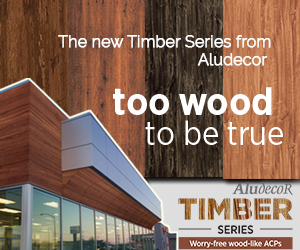At the core of architecture and construction lies the essential concept of structural integrity, the cornerstone of any successful project. Within the realm of Aluminium Composite Panel (ACP) structures, calculating composite panel deflection limits emerges as a pivotal consideration in the design process. Understanding deflection and its precise calculation is paramount in facade design for several reasons.
First and foremost, to calculate the deflection of aluminium composite panels, the Aludecor deflection calculator has been one of the most preferred tools for fabricators and designers. The calculation directly impacts the overall stability and safety of the structure, ensuring that it can withstand various external forces, such as wind loads and seismic activity. Moreover, precise deflection calculations enable architects and engineers to anticipate potential issues early in the design phase, allowing for proactive measures to be implemented to mitigate risks and ensure compliance with building codes and standards. Furthermore, a thorough understanding of deflection facilitates the creation of aesthetically pleasing and functional facades that meet both structural and design requirements, ultimately enhancing the overall quality and longevity of the built environment. Having a clear idea on the possible factors affecting deflection in composite panels can help in designing the elevation that is both functionally and aesthetically sustainable.
Let’s find out the intricate factors shaping deflection in ACP structures, empowering architects and engineers with insights to address these challenges adeptly.
Terrain Roughness and Its Impact on Deflection:
Terrain roughness refers to the unevenness or irregularity of the landscape surrounding a structure, which can have a significant impact on its deflection characteristics. In the field of architecture and engineering, understanding the influence of terrain roughness is crucial for designing resilient and structurally sound buildings. It particularly helps in understanding how to prevent sagging in aluminium composite panels.
The terrain roughness surrounding a structure affects deflection by altering the distribution of forces acting upon it. In areas with rugged terrain or uneven landscapes, the structural elements of a building may experience uneven loading, leading to differential deflection across the structure. Additionally, terrain roughness can exacerbate the effects of external forces such as wind or seismic activity, further influencing deflection patterns.
Read also: How Weather Conditions Affect The Selection of ACP Sheets
Therefore, engineers must consider terrain roughness in their calculations and design processes before installing composite panel design for minimal deflection. It ensures the structural integrity of buildings, especially those in regions with challenging landscapes. By incorporating factors such as slope gradients, surface irregularities, and soil composition into their analyses, engineers can calculate the deflection of aluminium composite panels and develop effective strategies to mitigate the impact of terrain roughness on the structures.
Height and Size of the Structure:
Height and size directly impact deflection due to the increased gravitational forces exerted on larger and taller structures. As buildings grow in height or size, they are subjected to greater loads, resulting in higher levels of stress and deformation. This phenomenon is particularly pronounced in materials with limited elasticity, particularly in ACP sheets which are very commonly used in modern architectural designs – both commercial as well as residential projects.
Read also: Introducing Stress & Deflection Calculator of Aludecor
Structural analyses, including finite element modeling and load calculations, are essential tools in predicting composite panel design for minimal deflection. By accounting for factors such as material properties, support systems, and environmental conditions, engineers can optimize the design to minimize deflection and ensure the structural integrity of the building.
Impact of Local Topography:
Local topography, including nearby mountains, valleys, or bodies of water, can have a significant impact on deflection in ACP structures. Wind patterns and atmospheric conditions influenced by local topography can exert varying forces on the structure, leading to differential deflection. Architects and engineers must conduct thorough site assessments to understand the unique topographical features and their potential impact on deflection.
ACP Size and Composition:
The size and composition of the ACP panels themselves play a crucial role in determining deflection. Factors such as the length, width, and thickness of the panels, as well as the top and bottom aluminium skin, modulus of elasticity, and alloy grade of aluminium, all contribute to the structural performance of the ACP system. Engineers must carefully select ACP materials and configurations that meet the specific deflection requirements of the project.
Wind Speed and Its Influence on Deflection:
Wind speed is another critical factor that can significantly influence deflection in ACP structures. High wind speeds exert lateral forces on the building envelope, causing it to deflect and potentially compromising its structural integrity. Engineers must conduct wind load calculations and design ACP systems capable of withstanding the expected wind speeds in the area to minimize deflection and ensure the safety of the structure.
Calculating deflection in ACP structures requires a comprehensive understanding of various critical factors. By considering terrain roughness, structure size, local topography, ACP size and composition, and wind speed, architects and engineers can design robust and resilient ACP structures that withstand deflection challenges effectively. With careful planning and meticulous attention to detail, ACP buildings can achieve both aesthetic appeal and structural durability in diverse environments.
For fabricators and designers, there is an Aludecor deflection calculator which can help them find the precise value and get the installation design done accordingly. To find out more about stress and deflection, reach out to the experts at https://www.aludecor.com/enquiry



